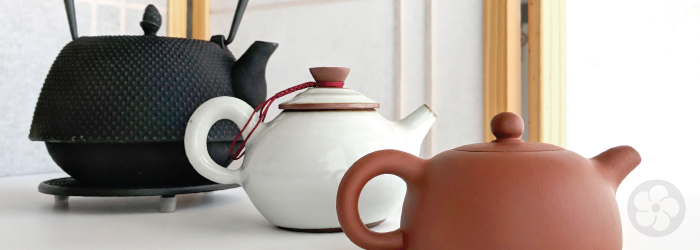Picking the Perfect Teapot: Cast Iron vs. Ceramic

Picking the right teapot can be difficult, whether it’s for your first brewing set or just a new addition to your growing collection. Finding a single pot with the right combination of size, pour, and heat retention is critical, since these factors can directly impact the flavor of your brew. Add aesthetics to the mix, and the perfect pot can seem elusive, if not imaginary. One way to narrow the search is to consider the material the pot is made of.
Cast iron teapots, for instance, have gained great popularity in modern times, and are commonly used to serve tea in cafes or restaurants. In contrast, most tea connoisseurs opt for small pots, often made of unglazed clay, for their daily brewing sessions. What is the difference, and which material is the best choice for your next brewing vessel?
Cast Iron Teapots
Cast Iron teapots have become popular in the Western tea-drinking world because they are well suited to Western brewing conventions. They are typically fairly large in size, and retain heat exceptionally well. When used with bagged teas or a simple infuser basket, the leaves can be removed to control the strength of the brew, and the pot of brewed tea will remain warm long enough to have more than one cup. They are a common choice in restaurants and cafes because they are extremely durable, and aesthetically pleasing, with a distinctive and traditional look.
But these heavy metal pots were not traditionally used as we use them today. Today’s cast iron pots are modeled after traditional Japanese tetsubin, which were placed over charcoal stoves to heat water. Tetsubin are still valued by many serious tea drinkers (as they are said to improve water quality) but are also difficult to care for and use. Constant contact with water makes rust an eternal threat to the long-term integrity of the iron, and dramatic temperature changes can cause stress fractures in aging, brittle metal.
The modern addition of enamel on the interior prevents rusting, but makes these new pots unsuitable for the high-temperature heating the original tetsubin were used for. Most of today’s cast iron pots are therefore only meant for brewing tea after the water has been heated in a separate kettle. Usually, they come with a wire mesh infuser basket to contain brewing leaves. This transformation makes them well suited to traditional European black tea styles, which brew well at high heat and consist of small leaf pieces that don’t need much space to expand.
Ceramic Teapots
Ceramic teapots come in endless variations, in both Asian and European traditions. Differences in locally available clays, craftsmanship, and firing techniques can all dramatically impact the heat retention and brewing performance of a ceramic pot, as well as the aesthetic style. As drinkers of Chinese tea, we like to use small pots that give us a lot of control over the temperature and taste of each small cup, and allow us to do multiple infusions. High quality pots made for use with whole leaf tea usually also have a strainer built into the spout, so that no mesh basket is needed and the leaves can fully expand.
Though they are easier to maintain than cast iron, ceramic pots can chip or break more easily. Small, delicate pots are often favored by connoisseurs for precise pours and good balance, but can look dainty and fragile to the uninitiated. But as clay is fired at high temperatures, silica inclusions align and becomes glass-like. As temperatures get higher and this molecular structure gets denser, the fired clay becomes more durable. Though Jingdezhen porcelain is exceedingly thin, high firing temperatures make the edges resistant to chipping, while thicker clays fired at low temperatures usually chip more easily.
Many connoisseurs of Chinese tea choose the style of their pot based on the tea they plan to brew, since regional ceramic styles developed alongside regional tea styles. Paper porcelain from Jingdezhen is highly prized for brewing the delicately flavored green and white teas from neighboring Zhejiang and Fujian, while heavier stoneware clays like Yixing are more popular in southern areas that produce oolongs or pu-erhs. Some traditional Chinese pots are left unglazed and meant to be dedicated to one style of tea, but any pot with a glazed interior can be used for lots of different teas without impacting flavor.
Though it may be only the first of many decisions in the hunt for the perfect pot, choosing the right material can help ensure that your pot will be well suited to your favorite teas.
What type of pot do you use daily? Tell us about your teaware collection in the comments below!
Sign up for our newsletter to get blog updates in your inbox!






Comments on this post (1)
Love your work and creativity. Keep up the fantastic work!!
— Jerry